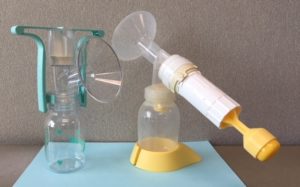Your milk can be expressed (removed from your breast) by hand or by using a breast pump. You may need to express your milk for several reasons
Reasons for expressing
You may need to express your milk to:
- Provide milk if your baby is not able to latch
- Soften your breasts before feeding (if your breasts are engorged and your baby is having problems latching)
- Provide milk for your sick or preterm baby
- Provide milk if you are away from your baby
- Make your breasts more comfortable and maintain your milk supply if you are not able to breast/chestfeed
You will find it easier to express your milk after:
- Your baby has fed
- Using warm moist heat on your breasts (shower, towels, or facecloths)
- Using breast massage
- The morning feeding when you have more milk
- Or during touching or cuddling your baby as this helps you produce breast/chestfeeding hormones

At first you may not be able to express any milk or very little milk. This is normal. As you become more comfortable with hand expression or using a breast pump, your milk will flow more easily. After a few days your milk supply will increase. It is normal for the amount of milk expressed to vary each time.
Methods of expressing
Breast massage before expressing milk may help you remove more milk.
- Always handle your breasts gently. Rough handling may damage delicate breast tissue
- Massage your breasts in small circular motions toward your nipple and/or stroke your breasts very gently toward the nipple
- Lean forward and let gravity help the milk flow
Hand expression
Hand expression is a learned skill that you may need to practice. It may be easier to practice in the tub or shower or after feeding your baby.
To hand express:
- Use a clean container with a wide opening (sterilize the container if your baby is less than 4 months old). Put the container on a surface in front of you, or hold it under your breast to collect the milk.
- With clean hands – hold your breast with one hand, with your fingers further back than the areola (dark area around the nipple). The thumb and index finger of your hand need to be opposite of each other and about 2.5–4 cm (1–1.5 inches) back from the nipple.
- Lift your breast slightly with the fingers that are under your breast. Push straight back in towards your chest and gently squeeze your thumb and fingers together, rolling them forward towards the nipple. Continue until your milk starts to flow. Don’t squeeze the base of your nipple, as this will stop the flow of milk.
- Rotate your hand around your breast and areola repeating the above motion until your milk flow decreases and your breast feels soft. If you are not getting any milk flow move your fingers slightly further back.
- Repeat with your other breast.
Pumps

Pumps may be used instead of hand expression. There are different types of pumps available.
- Manual, battery-operated and small electric pumps are for occasional pumping once your milk supply is established
- Rental hospital grade pumps are advised if you need to maintain or establish milk supply for a baby that is having difficulties latching or is preterm or sick
Do not buy a pump before you have your baby. If you do need a pump later, ask a health care professional who is knowledgeable about breast/chestfeeding for more information about a pump for your specific situation. Always follow the manufacturer’s instructions for use and cleaning.